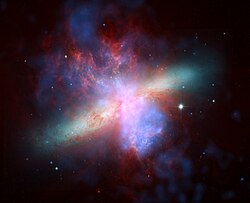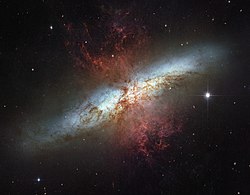Messier 82
| Galaxie Messier 82 | |
|---|---|
 | |
| Aufnahme des Hubble-Weltraumteleskops | |
| AladinLite | |
| Sternbild | Großer Bär |
| Position Äquinoktium: J2000.0, Epoche: J2000.0 | |
| Rektaszension | 09h 55m 52,7s [1] |
| Deklination | +69° 40′ 46″ [1] |
| Erscheinungsbild | |
| Morphologischer Typ | I0;Sbrst HII[1] |
| Helligkeit (visuell) | 8,6 mag[2] |
| Helligkeit (B-Band) | 9,2 mag[2] |
| Winkelausdehnung | 11,2′ × 4,3′[2] |
| Positionswinkel | 65°[2] |
| Flächenhelligkeit | 12,7 mag/arcmin²[2] |
| Physikalische Daten | |
| Zugehörigkeit | M81-Gruppe Virgo-Superhaufen, LGG 176[1][3] |
| Rotverschiebung | 0,000677 ± 0,000013[1] |
| Radialgeschwindigkeit | (203 ± 4) km/s[1] |
| Hubbledistanz H0 = 73 km/(s • Mpc) | (13 ± 2) · 106 Lj (3,835 ± 0,73) Mpc [1] |
| Durchmesser | 40.000 Lj[4] |
| Geschichte | |
| Entdeckung | Johann Elert Bode |
| Entdeckungsdatum | 31. Dezember 1774 |
| Katalogbezeichnungen | |
| M 82 • NGC 3034 • UGC 5322 • PGC 28655 • CGCG 333-008 • MCG +12-10-11 • IRAS 09517+6954 • Arp 337 • GC 1950 • H IV 79 • 3C 231 • KCPG 218B • Bode 18 • Koehler 8B | |
Messier 82 (auch als NGC 3034, M82 oder „Zigarrengalaxie“[5] bezeichnet) ist eine Spiralgalaxie mit den Abmessungen 11,2′ × 4,3′ und der scheinbaren Helligkeit von 8,6 mag im Sternbild Großer Bär.
M82 ist gravitativ an die etwas größere Spiralgalaxie M81 gebunden und bildet mit dieser den Kern der M81-Galaxiengruppe.
Beschreibung
Lange Zeit wurde M82 dem irregulären Galaxietyp zugeordnet. Neuere Untersuchungen im nahen Infrarot zeigen jedoch Spiralarme. Die Galaxie entspricht damit wahrscheinlich dem morphologischen Typ einer Balkenspiralgalaxie (Sbc), das heißt, die Arme entspringen an den Enden eines in diesem Fall nicht besonders langen Balkens.
In ihrer Nähe befindet sich die helle Spiralgalaxie M81, mit der sie ein physikalisch gebundenes Paar und den Kern der etwa 12 Millionen Lichtjahre entfernten M81-Galaxiengruppe bildet. Durch die Wechselwirkung mit M81 bei einem nahen Vorbeiflug vor etwa 500 Millionen Jahren wurde die Galaxie M82 dramatisch verändert. Im inneren Bereich hat sich die Rate, mit der neue Sterne aus interstellarer Materie entstehen, stark erhöht (Starburst). Dadurch ist M82 eine der hellsten Infrarotgalaxien und eine der hellsten Galaxien im Radiobereich (Ursa Major A). Als Folge des Starburst entsteht durch Supernovaexplosionen eine turbulente Gasbewegung, die als Ausströmung senkrecht zur Galaxienebene von M82 beobachtet wird. Durch ihre Nähe und Helligkeit ist M82 eine der bestuntersuchten Starburstgalaxien.
M82 enthält in einem ihrer Sternhaufen die ultrahelle Röntgenquelle M82 X-1. Das mittelschwere Schwarze Loch mit rund 415 Sonnenmassen wird von einem überschweren Stern umkreist. Im Jahre 2014 wurde mit M82 X-2 eine weitere Ultraleuchtkräftige Röntgenquelle entdeckt, wobei die Strahlung hier von einem Röntgenpulsar ausgeht.
Halton Arp gliederte seinen Katalog ungewöhnlicher Galaxien nach rein morphologischen Kriterien in Gruppen. Diese Galaxie gehört zu der Klasse Verschiedene (Arp-Katalog).
Die Galaxie wurde am 31. Dezember 1774 von dem deutschen Astronomen Johann Elert Bode entdeckt.[6]
- Fotografische Aufnahme mit Beschriftung einiger prägnanter Himmelsobjekte in der Umgebung der Galaxien M 81 und M 82. Links und unten ist das Sternbild Großer Bär mit den Sternen Merak und Dubhe zu sehen. Rechts oben befindet sich das Sternbild Drache mit dem Stern Giausar (λ Draconis) in der Schwanzspitze des Drachen.
Supernova 2014J
Am 21. Januar 2014 entdeckten der Universitätsdozent Steve Fossey und vier Studenten vom University College London bei der Ausbildung am Teleskop im Außenbereich der Galaxie zufällig eine Supernova vom Typ Ia, nach gängiger Theorie also die Explosion eines Weißen Zwerges. Sie ist bereits auf Aufnahmen vom 15. Januar 2014 zu sehen und erhielt die Kennung SN 2014J.[7][8] Mit einer maximalen scheinbaren Helligkeit von 10,5 mag[9] war sie auffallend hell und daher auch mit kleineren Teleskopen optisch zu beobachten.
Auch mehrere Wochen nach der Entdeckung war die Supernova noch deutlich zu sehen: Am 17. Februar 2014 betrug ihre scheinbare Helligkeit rund 11 mag – das entspricht etwa 75 % der Gesamthelligkeit von M82.[10][11]
- Oben: Ansicht von M82 am 10. Dezember 2013. Unten: Ansicht am 21. Januar 2014 mit SN 2014J.
- SN 2014J in Messier 82 am 17. Februar 2014.
Andere Bilder
- Panorama-Infrarotaufnahme mithilfe des Spitzer-Weltraumteleskops
- Röntgenaufnahme von Chandra
- Aus Aufnahmen von SST, HST und Chandra zusammengesetztes Bild
- (c) ESA/Webb, NASA & CSA, A. Bolatto, CC BY 4.0Aufnahme im nahen Infrarot mithilfe des James-Webb-Weltraumteleskops
- (c) ESA/Webb, NASA & CSA, A. Bolatto, CC BY 4.0… und im mittleren Infrarot
- M81 und M82 mit einem Amateurteleskop
Literatur
- Michael König, Stefan Binnewies: Bildatlas der Galaxien: Die Astrophysik hinter den Astrofotografien, Stuttgart, 2019, Kosmos, S. 419
- Wolfgang Steinicke: Ein Albtraum der Familie Herschel. Sterne und Weltraum 46(2), S. 61–65 (2007), ISSN 0039-1263; Entdeckung der Galaxien M81 und M82
- Jeff Kanipe und Dennis Webb: The Arp Atlas of Peculiar Galaxies – A Chronicle and Observer´s Guide, Richmond 2006, ISBN 978-0-943396-76-7
Weblinks
- Hubble views new supernova in Messier 82 (engl.)
- Smoke without fire: a different view of the cigar galaxy (engl.)
- The smouldering heart of a celestial cigar (engl.)
- Chandra X-Ray Observatory
- M82 bei SEDS
- Ursa Maior A beim Max-Planck-Institut für Radioastronomie
- M82 aufgenommen in 2 semiprofessionellen Amateur-Sternwarten
- Astronomieblog-Eintrag zur Supernova PSN J09554214+6940260
- Rochesterastronomy zur Supernovaexplosion
- Supernova 2014J – jpuschnig.com
- Beobachtung einer Supernova – jpuschnig.com
(englisch)
- Spektrum.de: Sammlung von Amateuraufnahmen Messier 81, 82 & Umgebung
- ARP ATLAS OF PECULIAR GALAXIES
- Seligman Arp
- CDS Portal
Einzelnachweise
- ↑ a b c d e NASA/IPAC EXTRAGALACTIC DATABASE
- ↑ a b c d e SEDS: NGC 3034
- ↑ VizieR
- ↑ NASA/IPAC
- ↑ Messier Object 82. In: messier.seds.org. Abgerufen am 7. Dezember 2015.
- ↑ Seligman
- ↑ Peter Gotzner: Astronomischer Glückstreffer: Studenten entdecken Supernova per Zufall, Spiegel Online, 23. Januar 2014
- ↑ astronews.com 4. März 2014
- ↑ List of Supernovae. Abgerufen am 11. September 2020.
- ↑ Johannes Puschnig: Supernova 2014J – jpuschnig.com. Abgerufen am 7. Mai 2025.
- ↑ Johannes Puschnig: Beobachtung einer Supernova – jpuschnig.com. Abgerufen am 7. Mai 2025.
Auf dieser Seite verwendete Medien
Messier 82. Composite of Chandra, HST and Spitzer images. X-ray data recorded by Chandra appears in blue; infrared light recorded by Spitzer appears in red; Hubble's observations of hydrogen emission appear in orange, and the bluest visible light appears in yellow-green.
ABOUT THIS IMAGE:
Composite image of the active galaxy M82 from infrared observations by Spitzer Space Telecope in three wavelength bands coded in red (longest wavelength), green, and blue (shortest wavelengths). Visit Related Link to Spitzer/Caltech image Release of M82 for more information.
Object Names: M82, NGC 3034
Image Type: Astronomical
Credit: NASA/JPL-Caltech/C. Engelbracht (University of Arizona)Bildtafel der 110 Messier-Objekte. Diese Datei wird in der w:de:Template:Navigationsleiste Messierobjekte als Imagemap genutzt. Sie darf daher nicht durch eine andere Version überschrieben werden!
Autor/Urheber: Astro Klaus Heyersum, Lizenz: CC BY-SA 4.0
Amateueraufnahme der Galaxien M81 und M82
This image shows the core of galaxy Messier 82 (M82), where two ultraluminous X-ray sources, or ULXs, reside (X-1 and X-2). ULXs are regions that shine intensely with X-rays. Astronomers previously believed that all ULXs were the result of actively feeding black holes; as the black holes pull matter onto them from companion stars, the matter heats up and blazes with X-rays. X-2 is the largest point of light in the pink field, while X-1 is the large point to the right of X-2 (see annotations on the image).
NuSTAR has added a new twist to the mystery of ULXs by showing that one of the ULXs in M82, called M82 X-2, is not a black hole but a pulsar. The observatory's high-energy X-ray observations caught a telltale pulse of X-rays coming from the object. A pulsar is a leftover core of an exploded star that sends out rotating beams of high-energy radiation. Pulsars are not as massive as black holes, so researchers are confounded by the immense amount of radiation pouring out of this relatively puny, compact object.
Meanwhile, other researchers, using data from NASA's Rossi X-ray Timing Explorer, recently found evidence that the other ULX in M82, called M82 X-1, is indeed a black hole. They think it might belong to a long-sought intermediate-mass class -- a missing link between smaller, stellar-mass black holes and the gargantuan ones that dominate the centers of most galaxies. Together, these results suggest that ULXs may be more diverse than once believed.
The image is a combination of high-energy X-ray data taken by NuSTAR (pink) and lower-energy X-rays captured by NASA's Chandra X-ray Observatory (blue).ABOUT THIS IMAGE:
Composite image of the active galaxy M82 from x-ray observations by Chandra X-Ray Observatory in three energy bands coded in red (lowest energy x-ray photons), green, and blue (highest energy).
Object Names: M82, NGC 3034
Image Type: Astronomical
Credit: NASA/CXC/JHU/D.Strickland(c) ESA/Webb, NASA & CSA, A. Bolatto, CC BY 4.0
Featured in this NASA/ESA/CSA James Webb Space Telescope Picture of the Month is a nearby galaxy that outshines the Milky Way. This galaxy, called Messier 82 (M82) or the Cigar Galaxy, is situated just 12 million light-years away in the constellation Ursa Major. Despite being smaller than the Milky Way, M82 is five times as luminous as our home galaxy and forms stars ten times faster. M82 is classified as a starburst galaxy because it is forming new stars at a rate much faster than expected for a galaxy of its mass, especially at its centre. In visible-light images of M82, the central hotbed of activity is obscured by a network of thick and dusty clouds, but Webb’s infrared eyes are designed to peer through this cloudy veil and reveal the activity behind them.What caused M82’s burst of star formation? The answer likely lies with its neighbour, the larger spiral galaxy M81. Researchers suspect that the two galaxies have interacted gravitationally, sending gas pouring into M82’s centre millions of years ago. The influx of gas provided the raw material for new stars to form — and form they did! M82 is home to more than 100 super star clusters, some of which are still in the process of forming and are blanketed with dense, dusty gas. Super star clusters are more massive and luminous than typical star clusters; these each contain hundreds of thousands of stars.A previous Webb image of M82, featuring data from its Near-InfraRed Camera (NIRCam), was released in 2024. The earlier image focused on the very core of the galaxy, where individual clusters of young stars stand out against the clumps and tendrils of gas. This new image from Webb’s Mid-InfraRed Instrument (MIRI) provides a remarkable, mostly starless view of M82. The image is instead dominated by the emission from warm dust and intricate clouds of sooty organic molecules called polycyclic aromatic hydrocarbons or PAHs. The emission from the PAH molecules traces the galaxy’s broad outflows, which are launched by the intense radiation and winds from the hot young stars of the central super star clusters. Though super star clusters are the source of M82’s powerful galactic winds, the winds may spell the end for the galaxy’s starburst era: as the winds billow into intergalactic space, they likely carry with them the cool gas needed to form even more stars.[Image Description: An image of the central part of galaxy M82. Its disc, a narrow bar from the top to the bottom of the image, can be seen by its intense blue-white glow. Thick clouds of gas cover the scene, erupting from the galaxy’s core out to the left and right. The gas is mostly pale red in colour and richly textured, with ridges and cavities visible in great detail. A few stars in M82 are visible scattered across the gas.]
Autor/Urheber: Bautsch, Lizenz: CC0
Fotografische Aufnahme mit Beschriftung einiger prägnanter Himmelsobjekte in der Umgebung der Galaxien M 81 und M 82. Links ist das Sternbild Großer Bär mit den Sternen Merak und Dubhe zu sehen. Rechts oben befindet sich das Sternbild Drache mit dem Stern Lambda Draconis in der Schwanzspitze des Drachen.
To celebrate the Hubble Space Telescope's 16 years of success, the two space agencies involved in the project, NASA and the European Space Agency (ESA), are releasing this image of the magnificent starburst galaxy, Messier 82 (M82). This mosaic image is the sharpest wide-angle view ever obtained of M82. The galaxy is remarkable for its bright blue disk, webs of shredded clouds, and fiery-looking plumes of glowing hydrogen blasting out of its central regions.
Throughout the galaxy's center, young stars are being born 10 times faster than they are inside our entire Milky Way Galaxy. The resulting huge concentration of young stars carved into the gas and dust at the galaxy's center. The fierce galactic superwind generated from these stars compresses enough gas to make millions of more stars.
In M82, young stars are crammed into tiny but massive star clusters. These, in turn, congregate by the dozens to make the bright patches, or "starburst clumps," in the central parts of M82. The clusters in the clumps can only be distinguished in the sharp Hubble images. Most of the pale, white objects sprinkled around the body of M82 that look like fuzzy stars are actually individual star clusters about 20 light-years across and contain up to a million stars.
The rapid rate of star formation in this galaxy eventually will be self-limiting. When star formation becomes too vigorous, it will consume or destroy the material needed to make more stars. The starburst then will subside, probably in a few tens of millions of years.
Located 12 million light-years away, M82 appears high in the northern spring sky in the direction of the constellation Ursa Major, the Great Bear. It is also called the "Cigar Galaxy" because of the elliptical shape produced by the oblique tilt of its starry disk relative to our line of sight.
The observation was made in March 2006, with the Advanced Camera for Surveys' Wide Field Channel. Astronomers assembled this six-image composite mosaic by combining exposures taken with four colored filters that capture starlight from visible and infrared wavelengths as well as the light from the glowing hydrogen filaments.Autor/Urheber: UCL/University of London Observatory/Steve Fossey/Ben Cooke/Guy Pollack/Matthew Wilde/Thomas Wright, Lizenz: CC BY 3.0
Supernova in M 82 on 21 January 2014. (The same view, from 10 December 2013 for comparison). Observations from the w:University of London Observatory
Autor/Urheber: Johannes Puschnig, www.sonnensystem.at, Lizenz: CC BY 4.0
Supernova SN2014J in M82 aufgenommen am 17. 2. 2014 von Stockholm aus mit dem Albanova 1m f/11 Teleskop mittels Johnson BVR Filter (Farb-Komposit aus: B: 10min; V: 10min; R: 6min). Aufnahme: Johannes Puschnig
(c) ESA/Webb, NASA & CSA, A. Bolatto, CC BY 4.0
Featured in this NASA/ESA/CSA James Webb Space Telescope Picture of the Month is a nearby galaxy that outshines the Milky Way. This galaxy, called Messier 82 (M82) or the Cigar Galaxy, is situated just 12 million light-years away in the constellation Ursa Major. Despite being smaller than the Milky Way, M82 is five times as luminous as our home galaxy and forms stars ten times faster. M82 is classified as a starburst galaxy because it is forming new stars at a rate much faster than expected for a galaxy of its mass, especially at its centre. In visible-light images of M82, the central hotbed of activity is obscured by a network of thick and dusty clouds. Webb’s Near-InfraRed Camera (NIRCam) has drawn back these clouds, revealing the full brilliance of the galactic centre.What caused M82’s burst of star formation? The answer likely lies with its neighbour, the larger spiral galaxy M81. Researchers suspect that the two galaxies have interacted gravitationally, sending gas pouring into M82’s centre millions of years ago. The influx of gas provided the raw material for new stars to form — and form they did! M82 is home to more than 100 super star clusters, some of which are still in the process of forming and are blanketed with dense, dusty gas. Super star clusters are more massive and luminous than typical star clusters; these each contain hundreds of thousands of stars.A previous Webb NIRCam image of M82 was released in 2024. The earlier image focused on the very core of the galaxy, where individual clusters of young stars stand out against the clumps and tendrils of gas. This new image takes a broader view of M82’s brilliant centre, capturing the light of billions of stars as well as the glow of organic molecules called polycyclic aromatic hydrocarbons, or PAHs. Researchers used the new Webb data to identify plumes traced by the emission from PAH molecules. Each plume is only about 160 light-years wide, and the Webb images show that these plumes are made up of multiple individual clouds that are 16–49 light-years across — an incredible level of detail enabled by Webb’s sensitive instruments. These clouds appear to have been caught up in the galaxy’s powerful outflowing winds and whisked away from the galactic disc.Ultimately, this phenomenon points back to the galaxy’s remarkable abundance of massive star clusters: as these massive clusters form, their newborn stars sear the surrounding gas with high-energy radiation and particles, launching the outflowing wind that is traced by this NIRCam image.[Image Description: An image of the central part of galaxy M82. The galaxy’s disc extends from the top to the bottom of the image, emitting a blue-white glow. Gas erupts from the brightly shining centre, forming an hourglass-shaped plume of red and orange dust clouds to the left and right. Ridges and cavities in the gas are visible in great detail. Many distant galaxies can be seen in the background, as well as tiny pinprick stars in M82.]
























